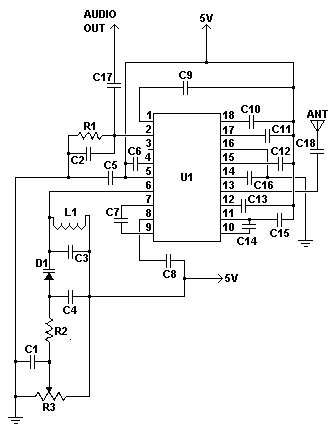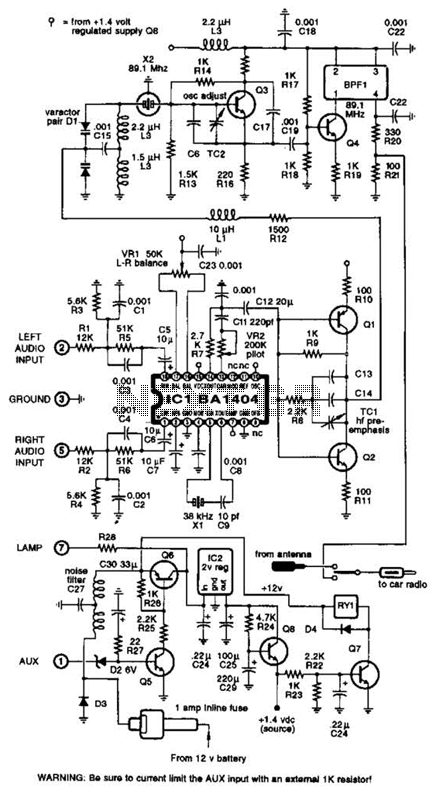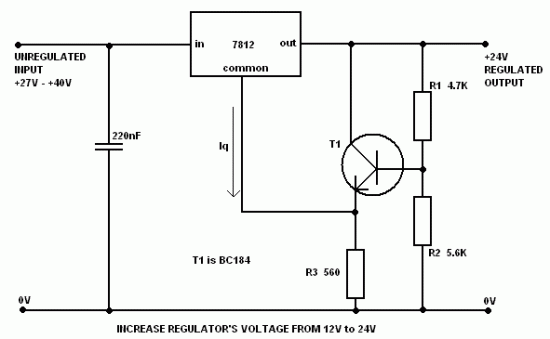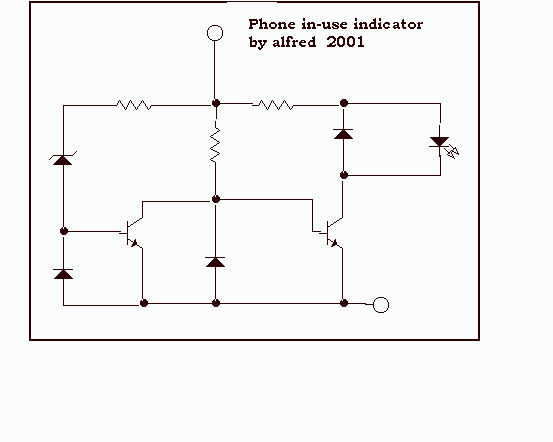
One second Audible Clock Circuit Schematic
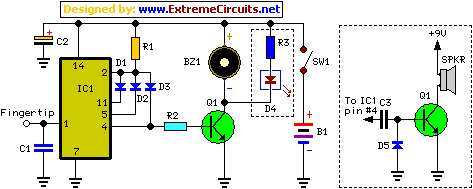
This precise one-pulse-per-second clock is constructed using a few common components and is driven by a 50 or 60 Hertz mains supply, without any direct connection to it. It produces a beep or metronome-like click and/or a visible flash to indicate one-second intervals, making it useful for various applications that require time-delay counting in seconds. The circuit utilizes a CMOS 4024 counter/divider chip and three diodes, configured to divide the frequency of the input signal at pin #1 by 50 or 60, depending on the mains frequency. The input impedance at pin #1 is very high, so merely touching the pin or connecting a short track or piece of wire to it typically suffices to provide the necessary input signal. An alternative method to generate an input signal involves wrapping a piece of wire several times around any convenient mains cable or transformer. No additional connections are required.
This one-pulse-per-second clock circuit is designed to provide a reliable timing signal suitable for various applications, such as timers, metronomes, or other devices requiring precise second intervals. The heart of the circuit is the CMOS 4024 counter/divider chip, which is capable of dividing the input frequency efficiently. The arrangement of the three diodes plays a crucial role in shaping the input signal and ensuring that the division process occurs correctly.
When powered, the circuit captures the 50 or 60 Hertz signal from the mains supply through the high-impedance input at pin #1. This allows the circuit to function without being directly connected to the mains, enhancing safety and reducing the risk of electrical interference. The high input impedance means that the circuit is sensitive enough to detect even minimal changes in voltage, which is ideal for applications where precision timing is essential.
The output of the CMOS 4024 chip generates a clean one-second pulse that can be used to trigger other devices or circuits. The beep or metronome-like click provides an audible indication of each pulse, while the visual flash serves as a secondary confirmation, making it suitable for environments where audible signals may not be easily perceived.
In summary, this one-pulse-per-second clock circuit is a versatile and efficient solution for generating accurate timing signals using common electronic components, making it accessible for hobbyists and professionals alike. The design's simplicity and effectiveness in producing a reliable one-second pulse make it an excellent choice for a wide range of timing applications.This accurate one-pulse-per-second clock is made with a few common parts and driven from a 50 or 60 Hertz mains supply but with no direct connection to it. A beep or metronome-like click and/or a visible flash, will beat the one-second time and can be useful in many applications in which some sort of time-delay counting in seconds is desirable.
Th e circuit is formed by a CMos 4024 counter/divider chip and 3 diodes, arranged to divide the frequency of the input signal at pin #1 by 50 (or 60, see Notes). The input impedance at pin #1 is very hight, so simply touching the pin (or a short track or piece of wire connected to it) is usually enough to provide the necessary input signal.
Another way to provide an input signal consists in a piece of wire wrapped several times around any convenient mains cable or transformer. No other connection is necessary. This accurate one-pulse-per-second clock is made with a few common parts and driven from a 50 or 60 Hertz mains supply but with no direct connection to it.
A beep or metronome-like click and/or a visible flash, will beat the one-second time and can be useful in many applications in which some sort of time-delay counting in seconds is desirable. The circuit is formed by a CMos 4024 counter/divider chip and 3 diodes, arranged to divide the frequency of the input signal at pin #1 by 50 (or 60, see Notes).
🔗 External reference
This one-pulse-per-second clock circuit is designed to provide a reliable timing signal suitable for various applications, such as timers, metronomes, or other devices requiring precise second intervals. The heart of the circuit is the CMOS 4024 counter/divider chip, which is capable of dividing the input frequency efficiently. The arrangement of the three diodes plays a crucial role in shaping the input signal and ensuring that the division process occurs correctly.
When powered, the circuit captures the 50 or 60 Hertz signal from the mains supply through the high-impedance input at pin #1. This allows the circuit to function without being directly connected to the mains, enhancing safety and reducing the risk of electrical interference. The high input impedance means that the circuit is sensitive enough to detect even minimal changes in voltage, which is ideal for applications where precision timing is essential.
The output of the CMOS 4024 chip generates a clean one-second pulse that can be used to trigger other devices or circuits. The beep or metronome-like click provides an audible indication of each pulse, while the visual flash serves as a secondary confirmation, making it suitable for environments where audible signals may not be easily perceived.
In summary, this one-pulse-per-second clock circuit is a versatile and efficient solution for generating accurate timing signals using common electronic components, making it accessible for hobbyists and professionals alike. The design's simplicity and effectiveness in producing a reliable one-second pulse make it an excellent choice for a wide range of timing applications.This accurate one-pulse-per-second clock is made with a few common parts and driven from a 50 or 60 Hertz mains supply but with no direct connection to it. A beep or metronome-like click and/or a visible flash, will beat the one-second time and can be useful in many applications in which some sort of time-delay counting in seconds is desirable.
Th e circuit is formed by a CMos 4024 counter/divider chip and 3 diodes, arranged to divide the frequency of the input signal at pin #1 by 50 (or 60, see Notes). The input impedance at pin #1 is very hight, so simply touching the pin (or a short track or piece of wire connected to it) is usually enough to provide the necessary input signal.
Another way to provide an input signal consists in a piece of wire wrapped several times around any convenient mains cable or transformer. No other connection is necessary. This accurate one-pulse-per-second clock is made with a few common parts and driven from a 50 or 60 Hertz mains supply but with no direct connection to it.
A beep or metronome-like click and/or a visible flash, will beat the one-second time and can be useful in many applications in which some sort of time-delay counting in seconds is desirable. The circuit is formed by a CMos 4024 counter/divider chip and 3 diodes, arranged to divide the frequency of the input signal at pin #1 by 50 (or 60, see Notes).
🔗 External reference

